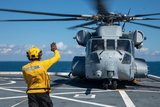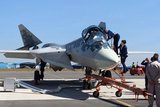EADS Aircraft, aervices provide relief as Haiti recovery continues
The US Army, Coast Guard and Air Force are employing helicopters, fixed-wing aircraft and services provided by EADS companies for humanitarian operations in Haiti -- assisting the multinational efforts that have followed the Jan. 12 earthquake there.
"We continue to be moved by the perseverance of the Haitian people in the face of this tragedy, and the amazing efforts of our uniformed services in assisting them," said EADS North America Chief Executive Officer Sean O'Keefe. "We're proud that our products in the hands of our customers are playing a role in that effort, and we hope that the contributions of EADS will have an equally positive impact."
EADS is matching employee donations to purchase and ship one of EADS Defense and Security's TransHospital modular field hospitals, which will be handed over permanently to local health authorities in Haiti. A similar TransHospital was deployed to Mississippi in 2005 following Hurricane Katrina, and was used to treat more than 5,000 patients. EADS is also supporting a series of humanitarian organizations from four different countries providing aid.
Airbus, the largest EADS division, sent an A340 jet to Haiti on Jan. 16, loaded with 20 tons of emergency cargo and seven members of an international rescue team. The plane then evacuated 80 people, including 16 children, to French Martinique.
Eurocopter, another EADS division, quickly mobilized an Ecureuil AS350B helicopter from the Dominican Republic. The aircraft is transporting physicians, medical equipment and other supplies, as well as performing medical evacuations day and night.
EADS Astrium's subsidiary Infoterra, which specializes in earth observation, provided satellite imagery that has been used to direct relief efforts, find useable landing zones for helicopters, and identify infrastructure where refugees could be housed or treated.
In addition to direct contributions from EADS, the US Coast Guard, Army and Air Force are all employing EADS-produced aircraft and systems in the relief effort.
US Coast Guard units were the first on scene in the Haitian capital of Port-au-Prince, and their HH-65C Dolphin helicopters and HC-144A Maritime Patrol Aircraft have been involved in the relief work from the start.
According to the Coast Guard, in the opening days of this historic, large-scale relief effort, the HC-144A seamlessly shifted between its cargo transport and its intelligence, surveillance and reconnaissance roles by providing immediate logistics support and assessments of ports and other critical infrastructure, using its organic sensor capabilities. Three HC-144s from Aviation Training Center Mobile, Ala., have logged more than 40 flight hours supporting the Haiti response.
The Ocean Sentries dispatched to Haiti are among eight HC-144As received by the Coast Guard to date as part of its recapitalization. The twin-engine aircraft is designed for maximum mission flexibility, and can quickly be reconfigured for medical evacuation (MEDEVAC) and passenger transport.
HH-65C and MH-65C Dolphin helicopters, from Air Station Detroit and Helicopter Interdiction Tactical Squadron Jacksonville, Fla., have provided logistics and MEDEVAC support in the most devastated areas. The Dolphin has a distinguished service record with the Coast Guard -- including extensive rescue support in the wake of Hurricane Katrina. The service's Dolphin helicopter fleet has been upgraded with new engines and systems/avionics in recapitalization programs supported by EADS North America.
Among the initial US Army assets sent to Haiti were two UH-72A Lakota Light Utility Helicopters from the Puerto Rico National Guard.
The Lakota is well suited for disaster response duties, combining a large cabin with the ability to rapidly load/unload patients through rear clamshell doors while the rotors are turning. The UH-72A's small overall footprint allows it to maneuver in close while producing less rotor wash than larger helicopters -- making operations safer in confined areas and small landing zones.
Also supporting the Haiti recovery efforts are Eagle Vision deployable ground stations operated by the Air National Guard, which are treating imagery data from commercial satellites to conduct damage assessments. By processing unclassified satellite imagery, the Eagle Vision stations are producing data that can be shared with emergency personnel and first responders, as well as disaster relief agencies.
The system also has been used in post-disaster responses following Hurricane Katrina, the 2004 Indian Ocean tsunami and California wildfires. The ground stations also have supported such military operations as Allied Force, Enduring Freedom and Iraqi Freedom.
Other EADS assets deployed to Haiti after the Jan. 12 earthquake include twin-engine tactical airlifters from the fleets of several foreign military services. The Brazilian Air Force and the Mexican Navy each sent C-295 aircraft; three CN-235s were dispatched from the French Armed Forces' overseas transport squadron in the West Indies; and the Dominican Republic provided the services of a C-212.
More from Defence Helicopter
-
![Germany to send WS-61 Westland Sea King helicopters to Ukraine]()
Germany to send WS-61 Westland Sea King helicopters to Ukraine
Germany has committed to sending Ukraine six of its 21 retiring WS-61 Westland Sea King multirole, amphibious helicopters.
-
![Boeing secures $271 million to advance modernisation of US Special Operations' MH-47G Chinook]()
Boeing secures $271 million to advance modernisation of US Special Operations' MH-47G Chinook
Boeing has clinched a major contract modification to further its backing of the US Special Operations Command’s MH-47G Chinook aircraft modernisation effort.
-
![Dubai Airshow 2023: South Korean homegrown helicopters make international debut]()
Dubai Airshow 2023: South Korean homegrown helicopters make international debut
Two KAI helicopters, the KUH-1E utility helicopter and the Light Attack Helicopter (LAH), have taken centre stage at the Dubai Airshow 2023.
-
![Italian Navy receives final NH90 helicopter]()
Italian Navy receives final NH90 helicopter
The Italian Navy now boasts a fleet of 56 NH90 helicopters comprising 46 SH-90As and 10 MH-90As.
-
![Argentina seeks AW109 and CH-46 Sea Knight helicopters]()
Argentina seeks AW109 and CH-46 Sea Knight helicopters
The Argentinian Air Force (FAA) and the Argentinian Naval Aviation Command (COAN) are looking for options to upgrade their helicopter fleets.
-
![DSEI 2023: Lockheed to produce about 40% of Black Hawks on UK soil if it wins NMH contest]()
DSEI 2023: Lockheed to produce about 40% of Black Hawks on UK soil if it wins NMH contest
Lockheed Martin promises a boost to the British job market and export opportunities, while strengthening ties with Poland and positioning the UK for a future in rotorcraft technology in the event of a New Medium Helicopter competition triumph.

























